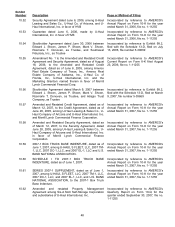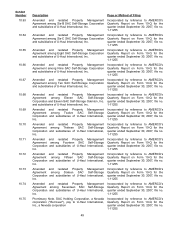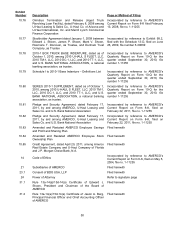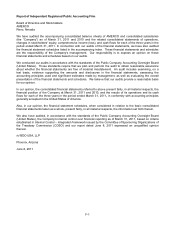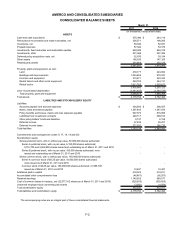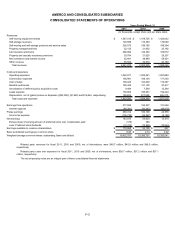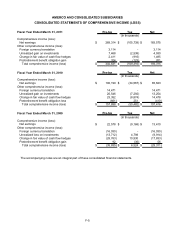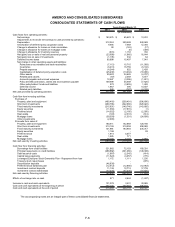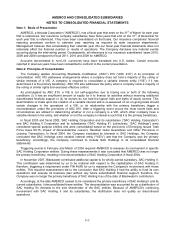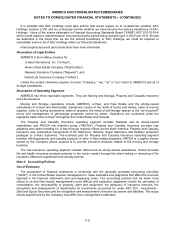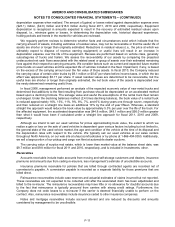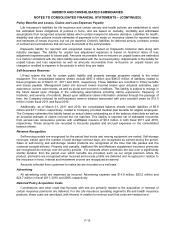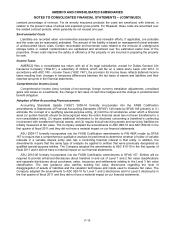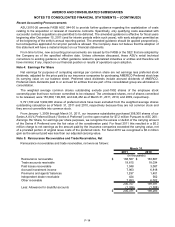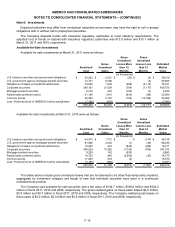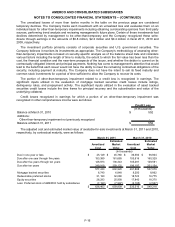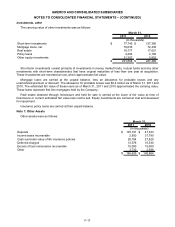U-Haul 2011 Annual Report Download - page 63
Download and view the complete annual report
Please find page 63 of the 2011 U-Haul annual report below. You can navigate through the pages in the report by either clicking on the pages listed below, or by using the keyword search tool below to find specific information within the annual report.AMERCO AND CONSOLIDATED SUBSIDIARIES
NOTES TO CONSOLIDATED FINANCIAL STATEMENTS
Note 1: Basis of Presentation
AMERCO, a Nevada Corporation (“AMERCO”), has a fiscal year that ends on the 31st of March for each year
that is referenced. Our insurance company subsidiaries have fiscal years that end on the 31st of December for
each year that is referenced. They have been consolidated on that basis. Our insurance companies’ financial
reporting processes conform to calendar year reporting as required by state insurance departments.
Management believes that consolidating their calendar year into our fiscal year financial statements does not
materially affect the financial position or results of operations. The Company discloses any material events
occurring during the intervening period. Consequently, all references to our insurance subsidiaries’ years 2010,
2009 and 2008 correspond to fiscal 2011, 2010 and 2009 for AMERCO.
Accounts denominated in non-U.S. currencies have been translated into U.S. dollars. Certain amounts
reported in previous years have been reclassified to conform to the current presentation.
Note 2: Principles of Consolidation
The Company applies Accounting Standards Codification (“ASC”) 810 (“ASC 810”) in its principles of
consolidation. ASC 810 addresses arrangements where a company does not hold a majority of the voting or
similar interests of a VIE. A company is required to consolidate a variable interest entity (“VIE”) if it has
determined it is the primary beneficiary. ASC 810 also addresses the policy when a company owns a majority of
the voting or similar rights and exercises effective control.
As promulgated by ASC 810, a VIE is not self-supportive due to having one or both of the following
conditions: (i) it has an insufficient amount of equity for it to finance its activities without receiving additional
subordinated financial support or (ii) its owners do not hold the typical risks and rights of equity owners. This
determination is made upon the creation of a variable interest and is re-assessed on an on-going basis should
certain changes in the operations of a VIE, or its relationship with the primary beneficiary trigger a
reconsideration under the provisions of ASC 810. After a triggering event occurs the most recent facts and
circumstances are utilized in determining whether or not a company is a VIE, which other company have a
variable interest in the entity, and whether or not the company’s interest is such that it is the primary beneficiary.
In fiscal 2003 and fiscal 2002, SAC Holding Corporation and its subsidiaries (“SAC Holding Corporation”)
and SAC Holding II Corporation and its subsidiaries (“SAC Holding II”) (collectively, “SAC Holdings”) were
considered special purpose entities and were consolidated based on the provisions of Emerging Issues Task
Force Issue 90-15, Impact of Nonsubstantive Lessors, Residual Value Guarantees and Other Provisions in
Leasing Transactions. In fiscal 2004, the Company evaluated its interests in SAC Holdings, the Company
concluded that SAC Holdings were variable interest entity (“VIE’s”) and that the Company was the primary
beneficiary. Accordingly, the Company continued to include SAC Holdings in its consolidated financial
statements.
Triggering events in February and March of 2004 required AMERCO to reassess its involvement in specific
SAC Holding Corporation entities. During these reassessments it was concluded that AMERCO was no longer
the primary beneficiary, resulting in the deconsolidation of SAC Holding Corporation in fiscal 2004.
In November 2007, Blackwater contributed additional capital to its wholly-owned subsidiary, SAC Holding II.
This contribution was determined by us to be material with respect to the capitalization of SAC Holding II;
therefore, triggering a requirement under FIN 46(R) for us to reassess the Company’s involvement with those
entities. This required reassessment led to the conclusion that SAC Holding II had the ability to fund its own
operations and execute its business plan without any future subordinated financial support; therefore, the
Company was no longer the primary beneficiary of SAC Holding II as of the date of Blackwater’s contribution.
Accordingly, at the date AMERCO ceased to be considered the primary beneficiary of SAC Holding II and its
current subsidiaries, it deconsolidated these entities. The deconsolidation was accounted for as a distribution of
SAC Holding II’s interests to the sole shareholder of the SAC entities. Because of AMERCO’s continuing
involvement with SAC Holding II and its subsidiaries, the distribution does not qualify as discontinued
operations.
F-7


